A stream crossing is a structure such as a culvert or a bridge that is located where a road, railroad, or trail crosses over a stream, river, lake or wetland. Across the State of New Hampshire, there are approximately 22,000 road-stream crossings. Many of these structures are old, damaged, and/or too small to properly transport water, sediment, and organic materials downstream. Underperforming stream crossings can present flood hazards, disruptions in transportation, and fish and wildlife impacts.
Flood Hazards and Public Safety
Stream crossings are a critical component of New Hampshire’s road transportation network; however, many of our culverts and bridges are too small to pass streamflow and sediment; a problem that will become worse with more frequent and intense rainstorms. When a crossing cannot accommodate the volume of water passing through during a storm, it will pass over the road or wash out the road fill materials, causing road collapse. There have been numerous occurrences across the state where roads have washed out due to inadequately sized culverts. Evaluating and upgrading our infrastructure to handle present and future climate events is essential to maintain a functional, reliable, and safe road transportation network.
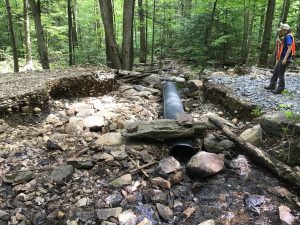
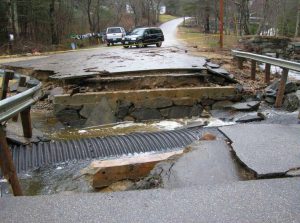
In July 2021, after heavy rains hit the region, several undersized culverts in southwestern NH washed out, including this small pipe in Alstead (left photo). When a culvert fails, this results in costly repairs and road closures like this road collapse in Barrington (right photo).
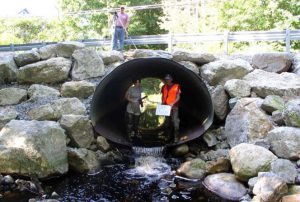
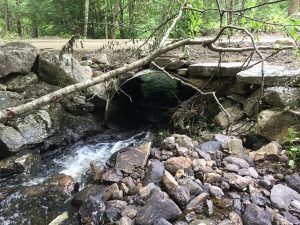
This pipe-arch culvert in Alstead, NH overtopped after a rainfall event caused regional flooding in August 2021. Notice the culvert perch (waterfall) and large scour pool at the outlet. On the upstream side, there is a blocked inlet, and a large deposit. In combination, these factors indicate an underperforming stream crossing.
Stream Connectivity and Wildlife Passage
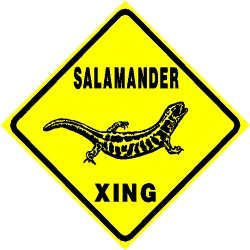
New Hampshire has a multitude of aquatic environments that are habitat to cold-water fish. These native species such as trout, American Shad, freshwater turtles, amphibians and invertebrates (like insects and freshwater mussels) are essential to our States freshwater ecosystems. Many of these animals must travel between different waterbodies throughout their life to sustain healthy populations. Streams crossings can be barriers to fish and wildlife movements, limiting their access to important breeding, nesting, and overwintering sites. The ability for aquatic organisms to have free passage through the stream network is critical to the ecology and health of the aquatic community. Many species of migratory fish, amphibians, freshwater invertebrates and turtles have experienced widespread population declines and are designated as “Species of Greatest Conservation Need” by New Hampshire Fish and Game Department.
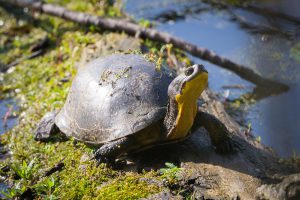
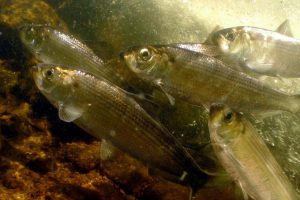
Blanding’s Turtle (left photo) and river herring (right photo) are species that rely on habitat continuity.
- Crossings with a perched outlet can prevent brook trout from reaching cold-water refuges in the summer and decrease genetic variation by isolating populations. With climate change and warmer stream temperatures, access to cold, headwater streams is critical for Brook Trout that are under increasing stress and environmental pressure.
- Blanding’s Turtles are a state-endangered freshwater turtle that must move between connected wetland complexes throughout their life for nesting and overwintering. Inadequate stream crossings are known to inhibit these reptiles from normal movements, forcing them to exit the waterbody to move past a barrier. Often forced to travel over the roadway; road mortality is confirmed to be a leading cause of turtle population declines in New Hampshire.
- Anadromous fish such as herring and American shad, spend most of their life in the marine environment, but must return to their natal rivers to spawn. Barriers such as dams and deficient stream crossings, block migrations and have led to significant populations declines in the Northeast.
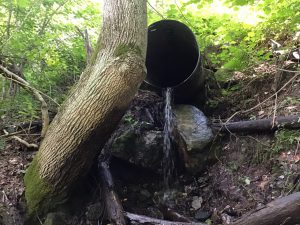
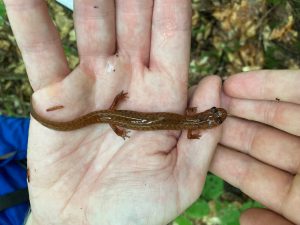
This culvert is perched of about 8 feet above the stream, making it impassable to all fish and wildlife, including local populations of salamanders, such as this spring salamander, that lay eggs in cold water streams.
Stream Crossings and the River Environment
Rivers and streams move nutrients, sediment, and organic materials downstream and onto floodplains. Crossings that do not fit with the natural channel shape or are undersized can seriously change the effectiveness of the structure. This eventually leads to a multitude of problems like erosion and scour that degrade habitat and water quality. When a crossing is too small to pass typical water flows, the water within the culvert then increases in velocity, scouring the streambed and eroding the banks. This type of damage can inhibit natural sediment transport and decrease water quality by means of sedimentation. Sedimentation occurs when the water become un-naturally cloudy due to sand/silt and other materials becoming mobile in the stream, typically this is a result of increased water velocity, and improperly constructed culverts.
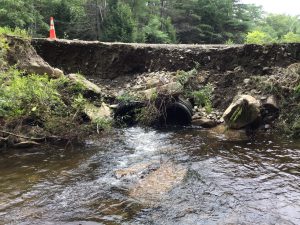
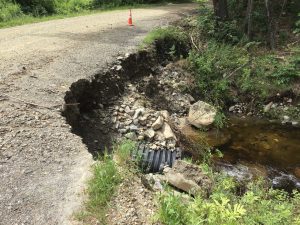
The streambed downstream of this culvert has been substantially eroded by high velocity water flows. Not only has the road experienced a washout in this area, but sedimentation continues to degrade water quality as a result of the conditions.
Infrastructure Condition and Our Roadways
The structural integrity of a crossing is critical to its overall performance and ability to pass water and sediment. Over time, the structure can become damaged from debris and erosion. When the structural condition is compromised, the area can become more vulnerable to flooding and road failure. A basic survey of the culvert, wingwalls, headwall, and bank stabilization is an asset management strategy used to prioritize maintenance and replacement. Road–stream crossing infrastructure represents large investments that are currently susceptible to catastrophic failure during large flood events, resulting in significant economic and societal losses to communities.
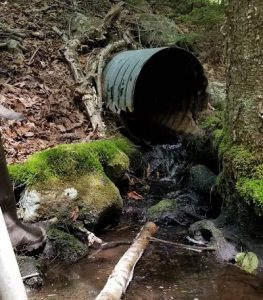
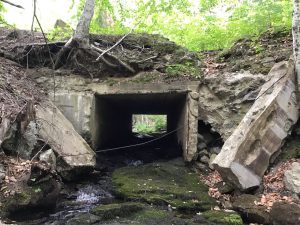
The bottom of this pipe has completely rusted out (left photo) and could lead to bank failure. The crumbling headwall and wingwalls of this box culvert have fallen into the stream and taken peices of road fill along with it into the stream (right photo).